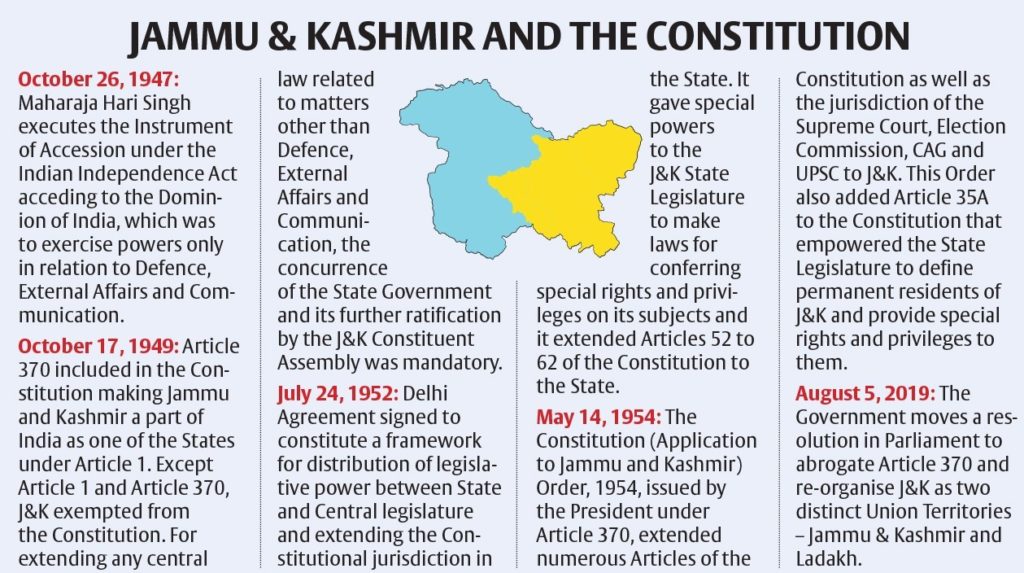Focus: GS-II Governance, Prelims
Why in news?
A five-judge Constitution Bench led by Justice N.V. Ramana on Monday declined a plea to refer to a larger Bench petitions challenging the abrogation of special status of Jammu and Kashmir under Article 370 of the Constitution.
The Bench said it would continue to hear the case on merits.
Conflict in Past Judgements on Status of Jammu and Kashmir
- The Bench had heard arguments and reserved its decision on whether there was a “direct conflict” between the judgments of 1959 and 1970 on the nature and extent of Article 370.
- The 1959 judgment, Prem Nath Kaul versus State of Jammu and Kashmir, indicated that Article 370 was applicable only till the Jammu and Kashmir Constitution was enacted on January 26, 1957. After that, no further changes could be made to the relationship between India and Jammu and Kashmir.
- But some petitioners argued that the Sampath Prakash versus State of Jammu and Kashmir judgment had ignored the 1959 verdict by concluding that Article 370 was permanent in nature and a “perennial source of power” for the Centre to govern its relationship with J&K.
Supreme Court’s Order on the Claimed Conflict
- Justice Ramana concluded that there was no conflict.
- The court explained that the “Constitution Bench in the Prem Nath Kaul case- did not discuss the continuation or cessation of the operation of Article 370 after the dissolution of the Constituent Assembly of the State.
- This was not an issue in question before the court, unlike in the Sampat Prakash case, where the contention was specifically made before, and refuted by, the court”.
- The order concluded that the court saw no reason to read into the Prem Nath Kaul case an interpretation that resulted in it being in confliict with its subsequent judgments.
Background
- On 5th August 2019, President of India in the exercise of the powers conferred by Clause (1) of Article 370 of the Constitution had issued the Constitution (Application to Jammu and Kashmir) Order, 2019. Through this, Government of India has made modifications in Article 370 itself (not revoked it).
- With this, the Government of India had dramatically altered the relationship between the state of Jammu and Kashmir and the Indian Union.

More about Article 370 of the past
- On October 17, 1949, Article 370 was added to the Indian constitution, as a ‘temporary provision’, which exempted Jammu & Kashmir, permitting it to draft its own Constitution and restricting the Indian Parliament’s legislative powers in the state.
- It was introduced into the draft constitution by N Gopalaswami Ayyangar as Article 306 A.
- Under Article 370: The Constituent Assembly of Jammu & Kashmir was empowered to recommend which articles of the Indian Constitution should apply to the state.
- The J&K Constituent Assembly was dissolved after it drafted the state’s constitution.
- Clause 3 of the article 370 gives the President of India the power to amend its provisions and scope.
- Article 35A stems from Article 370 and was introduced through a Presidential Order in 1954, on the recommendation of the J&K Constituent Assembly.
- Article 35A empowers the Jammu & Kashmir legislature to define the permanent residents of the state, and their special rights and privileges.
- It appears in Appendix I of the Constitution.





